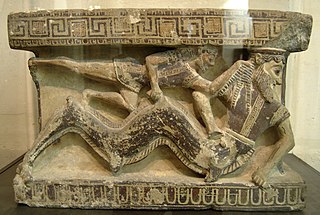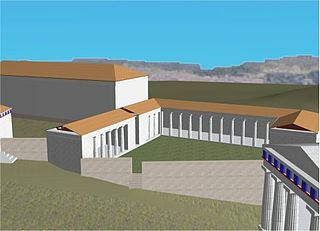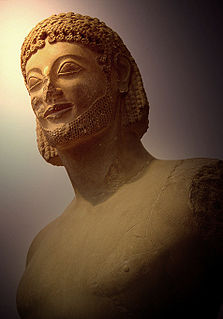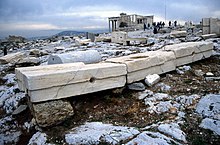
Laocoön, is a figure in Greek and Roman mythology and the Epic Cycle. Laocoon was a Trojan priest who was attacked, with his two sons, by giant serpents sent by the gods. The story of Laocoön has been the subject of numerous artists, both in ancient and in more contemporary times.

Pegasus is one of the best known creatures in Greek mythology. He is a winged divine stallion usually depicted as pure white in color. He was sired by Poseidon, in his role as horse-god, and foaled by the Gorgon Medusa. He was the brother of Chrysaor, born at a single birthing when his mother was decapitated by Perseus. Greco-Roman poets wrote about his ascent to heaven after his birth and his obeisance to Zeus, king of the gods, who instructed him to bring lightning and thunder from Olympus.

Sculpture is the branch of the visual arts that operates in three dimensions. Sculpture is the three-dimensional art work which is physically presented in the dimensions of height, width and depth. It is one of the plastic arts. Durable sculptural processes originally used carving and modelling, in stone, metal, ceramics, wood and other materials but, since Modernism, there has been an almost complete freedom of materials and process. A wide variety of materials may be worked by removal such as carving, assembled by welding or modelling, or moulded or cast.

Contrapposto is an Italian term that means "counterpoise". It is used in the visual arts to describe a human figure standing with most of its weight on one foot, so that its shoulders and arms twist off-axis from the hips and legs in the axial plane.

Triton is a Greek god of the sea, the son of Poseidon and Amphitrite, god and goddess of the sea respectively. Triton lived with his parents in a golden palace on the bottom of the sea. Later he is often depicted as having a conch shell he would blow like a trumpet.

The Trojan Horse was a wooden horse said to have been used by the Greeks during the Trojan War to enter the city of Troy and win the war. The Trojan Horse is not mentioned in Homer's Iliad, with the poem ending before the war is concluded, and it is only briefly mentioned in the Odyssey. But in the Aeneid by Virgil, after a fruitless 10-year siege, the Greeks constructed a huge wooden horse at the behest of Odysseus, and hid a select force of men inside, including Odysseus himself. The Greeks pretended to sail away, and the Trojans pulled the horse into their city as a victory trophy. That night, the Greek force crept out of the horse and opened the gates for the rest of the Greek army, which had sailed back under cover of darkness. The Greeks entered and destroyed the city, ending the war.

Phidias or Pheidias was a Greek sculptor, painter, and architect. His Statue of Zeus at Olympia was one of the Seven Wonders of the Ancient World. Phidias also designed the statues of the goddess Athena on the Athenian Acropolis, namely the Athena Parthenos inside the Parthenon, and the Athena Promachos, a colossal bronze which stood between it and the Propylaea, a monumental gateway that served as the entrance to the Acropolis in Athens. Phidias was the son of Charmides of Athens. The ancients believed that his masters were Hegias and Ageladas.

Praxiteles of Athens, the son of Cephisodotus the Elder, was the most renowned of the Attica sculptors of the 4th century BC. He was the first to sculpt the nude female form in a life-size statue. While no indubitably attributable sculpture by Praxiteles is extant, numerous copies of his works have survived; several authors, including Pliny the Elder, wrote of his works; and coins engraved with silhouettes of his various famous statuary types from the period still exist.

Sicyon or Sikyon was an ancient Greek city state situated in the northern Peloponnesus between Corinth and Achaea on the territory of the present-day regional unit of Corinthia. An ancient monarchy at the times of the Trojan War, the city was ruled by a number of tyrants during the Archaic and Classical period and became a democracy in the 3rd century BC. Sicyon was celebrated for its contributions to ancient Greek art, producing many famous painters and sculptors. In Hellenistic times it was also the home of Aratus of Sicyon, the leader of the Achaean League.

Polykleitos was an ancient Greek sculptor in bronze of the 5th century BCE. Alongside the Athenian sculptors Pheidias, Myron and Praxiteles, he is considered one of the most important sculptors of classical antiquity. The 4th century BCE catalogue attributed to Xenocrates, which was Pliny's guide in matters of art, ranked him between Pheidias and Myron. He is particularly known for his lost treatise, the Canon of Polykleitos, setting out his mathematical basis of an idealised male body shape.

Wood carving is a form of woodworking by means of a cutting tool (knife) in one hand or a chisel by two hands or with one hand on a chisel and one hand on a mallet, resulting in a wooden figure or figurine, or in the sculptural ornamentation of a wooden object. The phrase may also refer to the finished product, from individual sculptures to hand-worked mouldings composing part of a tracery.

A quadriga is a car or chariot drawn by four horses abreast and favoured for chariot racing in Classical Antiquity and the Roman Empire until the Late Middle Ages. The word derives from the Latin contraction of quadriiuga, from quadri-: four, and iugum: yoke.

The Charioteer of Delphi, also known as Heniokhos, is a statue surviving from Ancient Greece, and an example of ancient bronze sculpture. The life-size (1.8m) statue of a chariot driver was found in 1896 at the Sanctuary of Apollo in Delphi. It is now in the Delphi Archaeological Museum.

John Gibson was a Welsh Neoclassical sculptor who studied in Rome under Canova. He excelled chiefly in bas-relief, notably the two life-size works The Hours Leading the Horses of the Sun and Phaethon driving the Chariot of the Sun, but was also proficient in monumental and portrait statuary. He is famous for his statues of Sir Robert Peel, William Huskisson and Queen Victoria. Gibson was elected a Royal Academician in 1836, and left the contents of his studio to the Royal Academy, where many of his marbles and casts are currently on display.

The history of sculpture in the United States begins in the 1600s "with the modest efforts of craftsmen who adorned gravestones, Bible boxes, and various utilitarian objects with simple low-relief decorations." American sculpture in its many forms, genres and guises has continuously contributed to the cultural landscape of world art into the 21st century.

Chryselephantine sculpture is sculpture made with gold and ivory. Chryselephantine cult statues enjoyed high status in Ancient Greece.

The Brauroneion was the sanctuary of Artemis Brauronia on the Athenian Acropolis, located in the southwest corner of the Acropolis plateau, between the Chalkotheke and the Propylaea in Greece. It was originally dedicated during the reign of Peisistratos. Artemis Brauronia, protector of women in pregnancy and childbirth, had her main sanctuary at Brauron, a demos on the east coast of Attica.

The Mastos Painter was a painter of ancient Greek vases. He is named for a black-figure mastos used by the art historian John Boardman to illustrate the type, which is shaped like a woman's breast.

Ancient Greek art stands out among that of other ancient cultures for its development of naturalistic but idealized depictions of the human body, in which largely nude male figures were generally the focus of innovation. The rate of stylistic development between about 750 and 300 BC was remarkable by ancient standards, and in surviving works is best seen in sculpture. There were important innovations in painting, which have to be essentially reconstructed due to the lack of original survivals of quality, other than the distinct field of painted pottery.

Archaic Greek Sculpture represents the first stages of the formation of a sculptural tradition that became one of the most significant in the entire history of Western Art. The Archaic period of Ancient Greece is poorly delimited, and there is great controversy among scholars on the subject. It is generally considered to begin between 700 and 650 BC and end between 500 and 480 BC, but some indicate a much earlier date for its beginning, 776 BC, the date of the first Olympiad. In this period the foundations were laid for the emergence of large-scale autonomous sculpture and monumental sculpture for the decoration of buildings. This evolution depended in its origins on the oriental and Egyptian influence, but soon acquired a peculiar and original character.



















